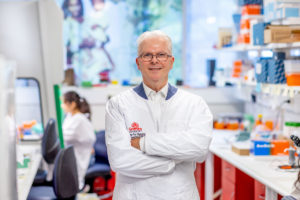Researchers from the Institute of Glycomics have been awarded more than $1,100,000 million in ³Ô¹ÏÍøÕ¾ Health and Medical Research Council (NHMRC) grant funding to develop new antibiotics for the treatment of multidrug resistant gonorrhoea infections.
This funding enables the team to delve further into the chemistry and potential application of new “zinc-binder” drugs under development to target a range of significant drug resistant bacterial infections.

Sexually transmitted disease gonorrhoea is caused by the bacterium Neisseria gonorrhoeae (Ng). Most gonococcal infections are asymptomatic and can lead to pelvic disease, infertility and increased risk of HIV co-transmission.
Due to the recent emergence of multidrug resistant superbugs, Ng is now classified as an immediate public-health threat. No vaccine is available.
Led by Director AO, the research team will build on their key discovery that Ng is sensitive to zinc-binding/carrying compounds.
“Applying our extensive experience in the fields of drug discovery and Neisseria research, we aim to develop a novel class of antibiotics to treat gonorrhoea and other bacterial infections,” Professor von Itzstein said.
Since the last entirely original class of antibiotics was discovered in the late 1980s, no new classes of antibacterial agents/drugs have been brought into medical use.
, Deputy Director of the Institute for Glycomics and a Chief Investigator on the grant, said that the World Health Organisation estimated that there were 106 million cases of gonorrhoea worldwide annually.

“Since this disease was first treated with penicillin in the 1940s, this bacterium has become resistant over the decades to each successive class of antibiotics that have been developed. New antibiotics are now needed to treat the infections with multi-drug resistant strains that have emerged and are becoming more widespread,” he said.
Professor von Itzstein said that our “zinc-binder” drug candidate approach has found great use in tackling drug resistant Streptococcus pneumoniae and Acinetobacter baumanni infection, which has recently been published in and respectively, as part of collaborative research with University of Melbourne and University of Queensland.
“Building on our Institute’s world-leading expertise in gonorrhoea research, this NHMRC grant will allow us to apply our zinc-binder drug discovery approach to drug resistant gonorrhoea infections and provides an exciting opportunity to develop a new solution for the treatment of a significant antibiotic-resistant infection, leading to commercialisation income for Australia,” he said.
ABOUT GONORRHEA
More than 1 million sexually transmitted infections (STIs) are acquired every day worldwide. Gonorrhoea represents a major proportion of these STIs, making it a global health priority. Gonorrhoea is caused by Neisseria gonorrhoeae(Ng) which primarily infects the female cervix and the male urethra.
Mothers with gonorrhoea can pass the bacteria to their baby during birth, resulting in neaonatal blindness. Moreover, gonorrhoea can cause long-term damage to the reproductive tract, leading to infertility. The US CDC and WHO list Ng as an urgent antibiotic resistance threat. Gonorrhoea infection also causes a higher risk of acquiring and transmitting HIV. There is no vaccine for gonorrhoea.








